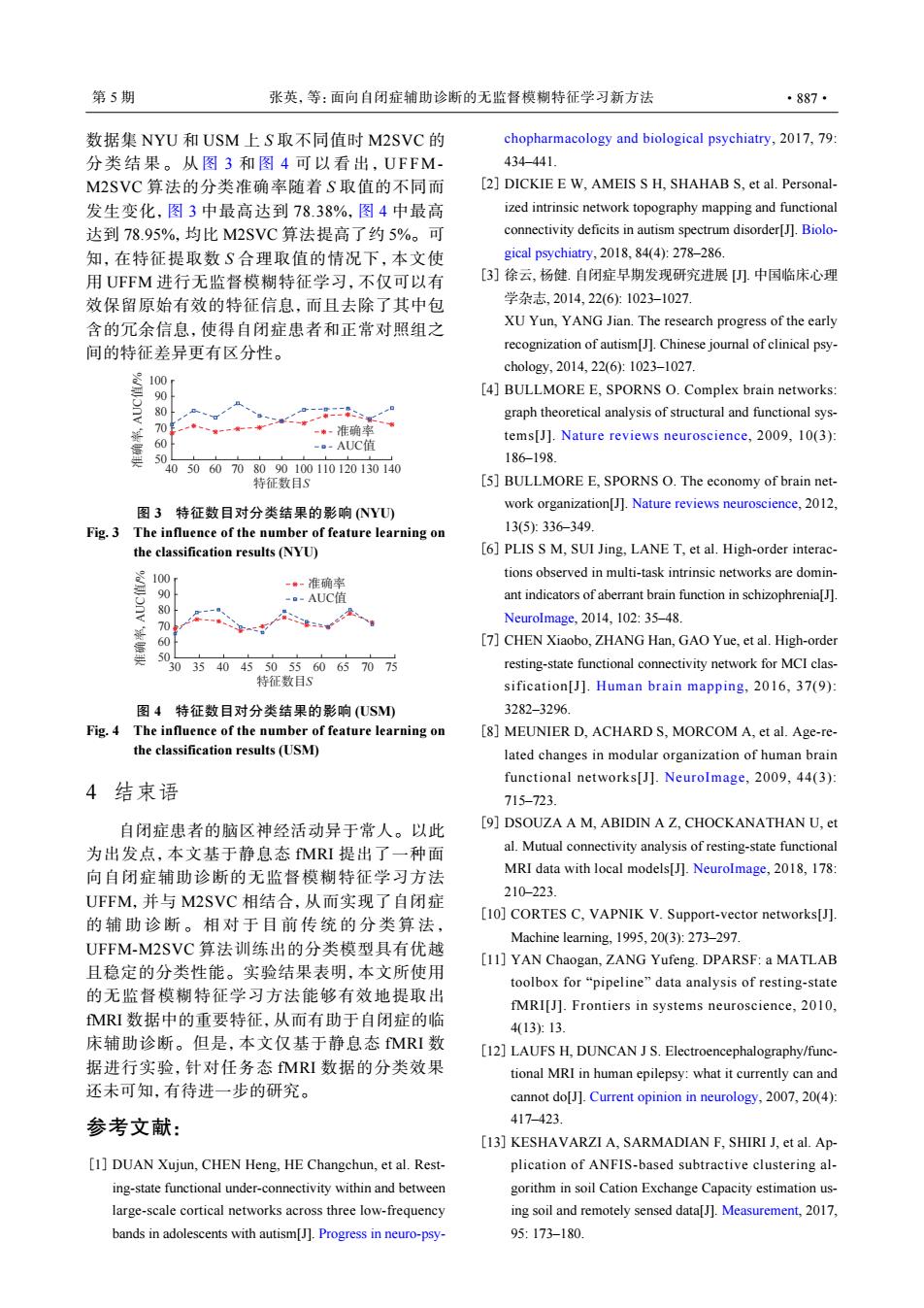正在加载图片...

第5期 张英,等:面向自闭症辅助诊断的无监督模糊特征学习新方法 ·887· 数据集NYU和USM上S取不同值时M2SVC的 chopharmacology and biological psychiatry,2017,79: 分类结果。从图3和图4可以看出,UFFM- 434-441 M2SVC算法的分类准确率随着S取值的不同而 [2]DICKIE E W.AMEIS S H.SHAHAB S,et al.Personal- 发生变化,图3中最高达到78.38%,图4中最高 ized intrinsic network topography mapping and functional 达到78.95%,均比M2SVC算法提高了约5%。可 connectivity deficits in autism spectrum disorder[J].Biolo- 知,在特征提取数S合理取值的情况下,本文使 gical psychiatry,2018,84(4):278-286. 用UFFM进行无监督模糊特征学习,不仅可以有 [3]徐云,杨健.自闭症早期发现研究进展).中国临床心理 效保留原始有效的特征信息,而且去除了其中包 学杂志,2014,22(6:1023-1027 含的冗余信息,使得自闭症患者和正常对照组之 XU Yun,YANG Jian.The research progress of the early 间的特征差异更有区分性。 recognization of autism[].Chinese journal of clinical psy- chology,2014,22(6:1023-1027. 100 90 [4]BULLMORE E,SPORNS O.Complex brain networks: 80 graph theoretical analysis of structural and functional sys- 70 一一准确率 60 tems[J].Nature reviews neuroscience,2009,10(3): 写类 -。-AUC值 50 186-198 05060708090100110120130140 特征数日S [5]BULLMORE E,SPORNS O.The economy of brain net- work organization[J].Nature reviews neuroscience,2012. 图3特征数目对分类结果的影响NYU) Fig.3 The influence of the number of feature learning on 13(5):336-349 the classification results (NYU) [6]PLIS S M,SUI Jing,LANE T,et al.High-order interac- 100 tions observed in multi-task intrinsic networks are domin- 一。-准确率 90 --AUC值 ant indicators of aberrant brain function in schizophrenia] 80 70 Neurolmage,.2014,102:35-48 60 [7]CHEN Xiaobo,ZHANG Han,GAO Yue,et al.High-order 50 30354045505560657075 resting-state functional connectivity network for MCI clas- 特征数目S sification[J].Human brain mapping,2016,37(9): 图4特征数目对分类结果的影响(USM) 3282-3296. Fig.4 The influence of the number of feature learning on [8]MEUNIER D.ACHARD S,MORCOM A,et al.Age-re- the classification results(USM) lated changes in modular organization of human brain functional networks[J].Neurolmage,2009,44(3): 4结束语 715-723. 自闭症患者的脑区神经活动异于常人。以此 [9]DSOUZA A M.ABIDIN A Z,CHOCKANATHAN U.et 为出发点,本文基于静息态fMRI提出了一种面 al.Mutual connectivity analysis of resting-state functional 向自闭症辅助诊断的无监督模糊特征学习方法 MRI data with local models[J].Neurolmage,2018,178: UFFM,并与M2SVC相结合,从而实现了自闭症 210-223 的辅助诊断。相对于目前传统的分类算法, [10]CORTES C,VAPNIK V.Support-vector networks[J]. Machine learning,1995,20(3):273-297 UFFM-M2SVC算法训练出的分类模型具有优越 [11]YAN Chaogan,ZANG Yufeng.DPARSF:a MATLAB 且稳定的分类性能。实验结果表明,本文所使用 toolbox for "pipeline"data analysis of resting-state 的无监督模糊特征学习方法能够有效地提取出 fMRI[J].Frontiers in systems neuroscience,2010. MRI数据中的重要特征,从而有助于自闭症的临 413:13 床辅助诊断。但是,本文仅基于静息态fMRI数 [12]LAUFS H.DUNCAN J S.Electroencephalography/func- 据进行实验,针对任务态MRI数据的分类效果 tional MRI in human epilepsy:what it currently can and 还未可知,有待进一步的研究。 cannot do[J].Current opinion in neurology,2007,20(4): 参考文献: 417-423 [13]KESHAVARZI A,SARMADIAN F,SHIRI J,et al.Ap- [1]DUAN Xujun,CHEN Heng,HE Changchun,et al.Rest- plication of ANFIS-based subtractive clustering al- ing-state functional under-connectivity within and between gorithm in soil Cation Exchange Capacity estimation us- large-scale cortical networks across three low-frequency ing soil and remotely sensed data[J].Measurement,2017, bands in adolescents with autism[].Progress in neuro-psy- 95:173-180数据集 NYU 和 USM 上 S 取不同值时 M2SVC 的 分类结果。从 图 3 和 图 4 可以看出, UFFMM2SVC 算法的分类准确率随着 S 取值的不同而 发生变化,图 3 中最高达到 78.38%,图 4 中最高 达到 78.95%,均比 M2SVC 算法提高了约 5%。可 知,在特征提取数 S 合理取值的情况下,本文使 用 UFFM 进行无监督模糊特征学习,不仅可以有 效保留原始有效的特征信息,而且去除了其中包 含的冗余信息,使得自闭症患者和正常对照组之 间的特征差异更有区分性。 特征数目S 准确率 40 50 60 70 80 90 100 110 120 130 140 ,AUC 值/% 50 60 70 80 90 100 准确率 AUC值 图 3 特征数目对分类结果的影响 (NYU) Fig. 3 The influence of the number of feature learning on the classification results (NYU) 特征数目S 准确率 30 35 40 45 50 55 60 65 70 75 ,AUC 值/% 50 60 70 80 90 100 准确率 AUC值 图 4 特征数目对分类结果的影响 (USM) Fig. 4 The influence of the number of feature learning on the classification results (USM) 4 结束语 自闭症患者的脑区神经活动异于常人。以此 为出发点,本文基于静息态 fMRI 提出了一种面 向自闭症辅助诊断的无监督模糊特征学习方法 UFFM,并与 M2SVC 相结合,从而实现了自闭症 的辅助诊断。相对于目前传统的分类算法, UFFM-M2SVC 算法训练出的分类模型具有优越 且稳定的分类性能。实验结果表明,本文所使用 的无监督模糊特征学习方法能够有效地提取出 fMRI 数据中的重要特征,从而有助于自闭症的临 床辅助诊断。但是,本文仅基于静息态 fMRI 数 据进行实验,针对任务态 fMRI 数据的分类效果 还未可知,有待进一步的研究。 参考文献: DUAN Xujun, CHEN Heng, HE Changchun, et al. Resting-state functional under-connectivity within and between large-scale cortical networks across three low-frequency bands in adolescents with autism[J]. Progress in neuro-psy- [1] chopharmacology and biological psychiatry, 2017, 79: 434–441. DICKIE E W, AMEIS S H, SHAHAB S, et al. Personalized intrinsic network topography mapping and functional connectivity deficits in autism spectrum disorder[J]. Biological psychiatry, 2018, 84(4): 278–286. [2] 徐云, 杨健. 自闭症早期发现研究进展 [J]. 中国临床心理 学杂志, 2014, 22(6): 1023–1027. XU Yun, YANG Jian. The research progress of the early recognization of autism[J]. Chinese journal of clinical psychology, 2014, 22(6): 1023–1027. [3] BULLMORE E, SPORNS O. Complex brain networks: graph theoretical analysis of structural and functional systems[J]. Nature reviews neuroscience, 2009, 10(3): 186–198. [4] BULLMORE E, SPORNS O. The economy of brain network organization[J]. Nature reviews neuroscience, 2012, 13(5): 336–349. [5] PLIS S M, SUI Jing, LANE T, et al. High-order interactions observed in multi-task intrinsic networks are dominant indicators of aberrant brain function in schizophrenia[J]. NeuroImage, 2014, 102: 35–48. [6] CHEN Xiaobo, ZHANG Han, GAO Yue, et al. High-order resting-state functional connectivity network for MCI classification[J]. Human brain mapping, 2016, 37(9): 3282–3296. [7] MEUNIER D, ACHARD S, MORCOM A, et al. Age-related changes in modular organization of human brain functional networks[J]. NeuroImage, 2009, 44(3): 715–723. [8] DSOUZA A M, ABIDIN A Z, CHOCKANATHAN U, et al. Mutual connectivity analysis of resting-state functional MRI data with local models[J]. NeuroImage, 2018, 178: 210–223. [9] CORTES C, VAPNIK V. Support-vector networks[J]. Machine learning, 1995, 20(3): 273–297. [10] YAN Chaogan, ZANG Yufeng. DPARSF: a MATLAB toolbox for “pipeline” data analysis of resting-state fMRI[J]. Frontiers in systems neuroscience, 2010, 4(13): 13. [11] LAUFS H, DUNCAN J S. Electroencephalography/functional MRI in human epilepsy: what it currently can and cannot do[J]. Current opinion in neurology, 2007, 20(4): 417–423. [12] KESHAVARZI A, SARMADIAN F, SHIRI J, et al. Application of ANFIS-based subtractive clustering algorithm in soil Cation Exchange Capacity estimation using soil and remotely sensed data[J]. Measurement, 2017, 95: 173–180. [13] 第 5 期 张英,等:面向自闭症辅助诊断的无监督模糊特征学习新方法 ·887·